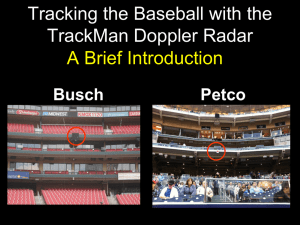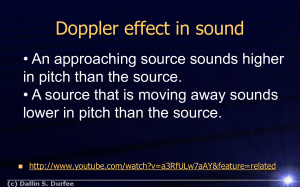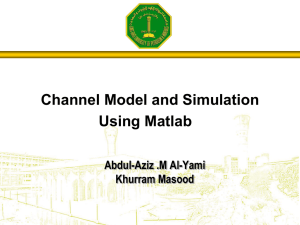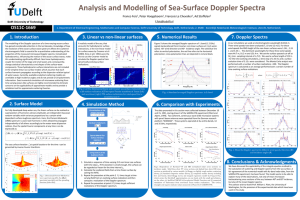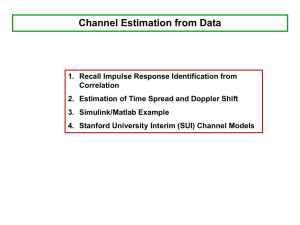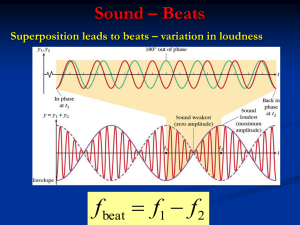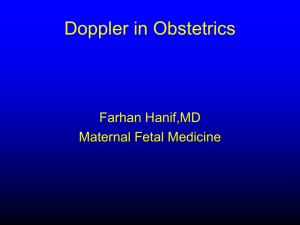Chapter7_level_1
advertisement
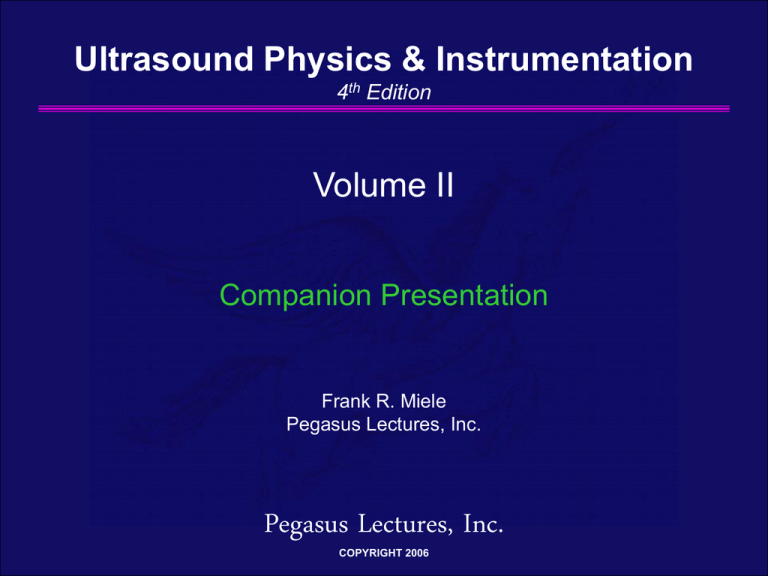
Ultrasound Physics & Instrumentation 4th Edition Volume II Companion Presentation Frank R. Miele Pegasus Lectures, Inc. Pegasus Lectures, Inc. COPYRIGHT 2006 License Agreement This presentation is the sole property of Pegasus Lectures, Inc. No part of this presentation may be copied or used for any purpose other than as part of the partnership program as described in the license agreement. Materials within this presentation may not be used in any part or form outside of the partnership program. Failure to follow the license agreement is a violation of Federal Copyright Law. All Copyright Laws Apply. Pegasus Lectures, Inc. COPYRIGHT 2006 Volume II Outline Chapter 7: Doppler Level 1 Level 2 Chapter 8: Artifacts Chapter 9: Bioeffects Chapter 10: Contrast and Harmonics Chapter 11: Quality Assurance Chapter 12: Fluid Dynamics Chapter 13: Hemodynamics Pegasus Lectures, Inc. COPYRIGHT 2006 Chapter 7: Doppler - Level 1 Level 1 focuses on: Developing a basic understanding of the Doppler Effect Developing a simplified form of the Doppler equation Level 2 focuses on completing the Doppler equation, understanding scattering from red blood cells, understanding the Doppler angle and angle effects, the Doppler block diagram, Doppler processing, effects of wall filters, PW vs. CW Doppler, range ambiguity, HPRF Doppler, and color Doppler. Pegasus Lectures, Inc. COPYRIGHT 2006 Applications of the Doppler Effect The Doppler effect has been employed for many different applications. One of the most prevalent applications is radar. The Doppler effect has been used with radar techniques to determine the velocity of moving objects such as airplanes, automobiles, boats, trains, and even storm systems. The same Doppler principles have also been employed in the medical field. This application has benefited from years of radar applications including advances designed to overcome limitations and artifacts. Pegasus Lectures, Inc. COPYRIGHT 2006 The Doppler Effect The Doppler Effect is an apparent change in frequency as a result of a change in wavelength caused by motion of a wave source relative to an observer. To demonstrate how the change in wavelength occurs we will consider what happens to a wave as it propagates over time. First we will consider the wave emanating from a stationary train. Then we will consider the wave as it emanates from a moving train. Finally, we will consider what happens to the same emanating wave if the train’s velocity is increased. From these three examples, we will appreciate how the Doppler shift occurs. Pegasus Lectures, Inc. COPYRIGHT 2006 Stationary Train and Wavelength Notice how the sound propagates over time creating uniform, concentric circles as the wave propagates away from the stationary source. Both Observer A and Observer B hear the same pitch whistle - as would be expected. Fig. 1: (Pg 520) Pegasus Lectures, Inc. COPYRIGHT 2006 Stationary Plane (Animation) (Pg 520) Pegasus Lectures, Inc. COPYRIGHT 2006 Moving Train and Change in Wavelength Notice how the sound propagating from the moving source results in a compression of the wavefronts towards Observer B and a decompression of the wavefronts relative to Observer A. Therefore, Observer A hears a lower pitch than the transmitted wave and Observer B hears a higher pitch than the transmitted wave. Fig. 2: (Pg 521) Pegasus Lectures, Inc. COPYRIGHT 2006 Moving Plane (Animation) (Pg 521) Pegasus Lectures, Inc. COPYRIGHT 2006 Fast Moving Train and Greater Change in Wavelength Now notice that the compression and decompression effect (the Doppler Effect) is increased by a faster moving train. This fact implies that the Doppler shifted frequency (fDop) is related to the velocity (v) of the train. As the velocity increases, the Doppler shift increases. Fig. 3: (Pg 522) Pegasus Lectures, Inc. COPYRIGHT 2006 Fast Moving Plane (Animation) (Pg 522) Pegasus Lectures, Inc. COPYRIGHT 2006 Doppler Shift and Velocity From the animations, we saw that the Doppler shift increased with increasing velocity. Mathematically, this relationship is expressed as: f Dop v Where: f Dop Doppler shifted frequency v velocity of the sound source Pegasus Lectures, Inc. COPYRIGHT 2006 Doppler Shift (a change in frequency) The Doppler shift is really a difference in frequency between the frequency that was transmitted and the frequency that was received. f Dop fdetected - f transmitted f If the detected frequency is lower than the transmitted frequency, the Doppler shift is negative. If the detected frequency is higher than the transmitted frequency, the Doppler shift is positive. Pegasus Lectures, Inc. COPYRIGHT 2006 The Doppler Shift (Examples) As just discussed, the Doppler shift fDop is relative to the transmit frequency. If the transmit frequency is 2.0 MHz: a received frequency of: 2.001 MHz fDop = 2.001 MHz – 2.000 MHz = + 0.001 MHz = +1 kHz 1.999 MHz fDop = 1.999 MHz – 2.000 MHz = - 0.001 MHz = -1 kHz What is the Doppler shift (fDop) if the transmit frequency is 5.0 MHz when the received frequency is: 5.003 MHz fDop = 5.003 MHz – 5.000 MHz = + 0.003 MHz = +3 kHz 4.998 MHz fDop = 4.998 MHz – 5.000 MHz = - 0.002 MHz = -2 kHz Pegasus Lectures, Inc. COPYRIGHT 2006 Doppler Shift and the Wavelength We showed that the Doppler shift is caused by a change of wavelength caused by motion relative to the observer. Since the wavelength is determined by both the frequency and the propagation velocity, we know that the Doppler equation will be effected by changes in both frequency and propagation velocity. c f Pegasus Lectures, Inc. COPYRIGHT 2006 Effect of Frequency on Doppler Effect As shown in the figure below, if the wavelength is 10 meters for a transmit frequency of “f”, then the wavelength would be 5 meters for a transmitted frequency of “2f” (frequency and wavelength are inversely related). Now imagine if the train moved one meter. Clearly one meter relative to 5 meters is a greater percentage than 1 meter relative to 10 meters. Hence, as the frequency increases, the Doppler Effect also increases. Fig. 4: (Pg 526) Pegasus Lectures, Inc. COPYRIGHT 2006 Doppler Shift and Operating Frequency As just shown in the previous slide, as the frequency increases, the Doppler shift increases: f Dop fo Where: f Dop Doppler shifted frequency f o Transmitted frequency (Operating Frequency) Pegasus Lectures, Inc. COPYRIGHT 2006 Effect of Propagation Velocity on Doppler Effect As shown in the figure below, if the wavelength is 5 meters for a propagation velocity of “c”, then the wavelength would be 10 meters for a propagation velocity of “2c” (propagation velocity and wavelength are directly related). Now imagine if the train moved one meter. Clearly one meter relative to 5 meters is a greater percentage than 1 meter relative to 10 meters. Hence, as the propagation velocity increases, the Doppler Effect decreases. Fig. 5: (Pg 527) Pegasus Lectures, Inc. COPYRIGHT 2006 Doppler Shift and Propagation Velocity As just shown in the previous slide, as the propagation velocity increases, the Doppler shift decreases: 1 f Dop c Where: f Dop Doppler shifted frequency c Propagation velocity of the wave in the medium Pegasus Lectures, Inc. COPYRIGHT 2006 Simplified Doppler Equation If we combine the three relationships we have just seen into one equation, we achieve the simplified form of the Doppler equation: f Dop 2 fov c Note that the additional constant factor of 2. The factor of 2 can be considered to account for the roundtrip effect. Pegasus Lectures, Inc. COPYRIGHT 2006 Add Title Blank Slide: This blank slide is here to help facilitate adding new content. If you would like to add material to this presentation, copy this slide and place in the correct location. Pegasus Lectures, Inc. COPYRIGHT 2006
